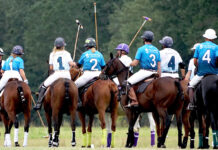Like most Americans, Fearn LaBan heard about the Japanese attack on Pearl Harbor over the radio. He was sitting at his grandmother’s house on Kirby Street. While the Murphy High School freshman wasn’t exactly sure where Pearl Harbor was, he knew the United States had been attacked, and he was mad. Three years later, with the war in full force, LaBan, though still a student, was eager to fight for his country. “We loved America and wanted to defend her. A lot of young people felt that way, ” LaBan, below right, humbly explains. At age 17, he convinced his mother to sign the papers for him to enlist in the Navy.
LaBan was one of hundreds of Murphy High School students who dropped out to join the military during World War II. His classmate Chester Feagin also left Murphy during his junior year. He wanted to go in the Navy sooner, but his parents wouldn’t give him permission. After their 18th birthday, twins John and Reginald Loper also decided to join the Navy. They, too, were driven by patriotism but also realized that they would rather choose their branch than get drafted.
 |
Uncharted Territory
Prior to their service, the young sailors lead average lives in the wartime South – their worlds didn’t stretch much farther than the Eastern Shore. “I was 15 before I left my front yard, ” LaBan jokes. Each of them ended up touring the Pacific, spending weeks at sea and in foreign places they had never heard of. Yet LaBan and the others were unimpressed by their journeys, seemingly unaware of the magnitude of what they were doing. “It wasn’t until I was older, ” Fearn says, “that I realized how unique my experiences were.”
Like most teenage boys, the 17- and 18-year-old servicemen felt bulletproof and fearless. “Except I was afraid of kamikaze attacks near Okinawa, ” Reginald says.
Other occasions made them all too aware of their own mortality. Reginald will never forget seeing the many makeshift graves of his fallen comrades. “Hundreds at a time and every other one was unknown, ” he adds.
On the Homefront
The war ended on Aug. 15, 1945, or V-J Day, when the Japanese surrendered to the Allied Forces. Feagin remembers that he was stationed in the Philippines, and the normally dark ships had “all put their lights on, and there were fireworks. It was a sight.”
When he returned home, Feagin went straight to Mobile’s employment office, hoping to find a job. He was informed that he would need a permit to work because he was not a high school graduate or 21 years old. “How could I be old enough to fight in the war, but not old enough to get a job?” he recalls asking. So, realizing that a diploma meant job opportunities, the sailors decided to return to finish their high school education.
In the fall of 1946, LaBan and the Lopers, by then all 19 years old, and Feagin, 20, reenrolled at Murphy. Most of the veterans were in a hurry to earn their degrees and move on with their lives. Murphy’s administration was also eager for them to graduate; with more than 3, 000 students in the mid-1940s, the school was bursting at the seams. The veterans took accelerated classes so they could graduate in half the regular time. Feagin earned 14 credits in one semester and received his diploma in January 1947. In total, more than 200 veterans graduated from Murphy from 1946 to 1948.

ABOVE The Navy was by far the most popular military branch for Murphy students. Both LaBan and Feagin hypothesize that the Navy was a natural fit for boys who grew up on the Gulf Coast.
The former soldiers mostly attended classes together, allowing them to form a support system where they could talk about their wartime experiences. The teachers and administrators were also helpful with the transition. “Assistant principal Louise Hamil took the veterans under her wing, ” Feagin remembers. “She met you one time, and from then on she knew your name.”
John Loper recalls that they didn’t get “too buddy-buddy with the underclassmen.” He remembers, “There were some pretty girls, but we didn’t try to steal the younger guys’ sweethearts.” LaBan did fall in love with a younger student, Jane Foster, class of 1949. They’ve been married for 64 years.
Being an older pupil came with its perks, including an exemption from gym class, a special smoking section, and privileges to leave campus. “It was hard for teachers to tell us ‘Yes, you can go off to war, but no, you can’t go to Albright and Woods [soda fountain] for lunch, ” LaBan explains.
Each of the men looks back fondly on their time at Murphy. “It was such a special school, ” LaBan recalls. “I treasure all of the friendships, and the phenomenal education I received there.” Feagin remembers that all involved showed such “great esprit de corps. We had good teachers, bright students and an enthusiasm for Murphy. It wasn’t until we left that we realized how wonderful it was.”
Nov. 11: Veterans Day Celebration and Mobile Pops Concert
USS Alabama Battleship Memorial Park, Aircraft Pavilion • 2703 Battleship Parkway • Mobile Pops • 679-6036
10 a.m. – 9 p.m. 7 p.m. concert. Festivities saluting men and women who served our country.
text by Holly Jansen • photos courtesy Fearn Laban





